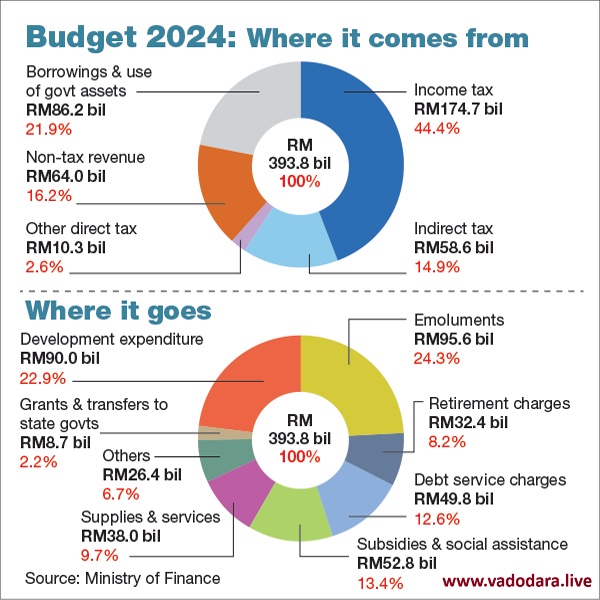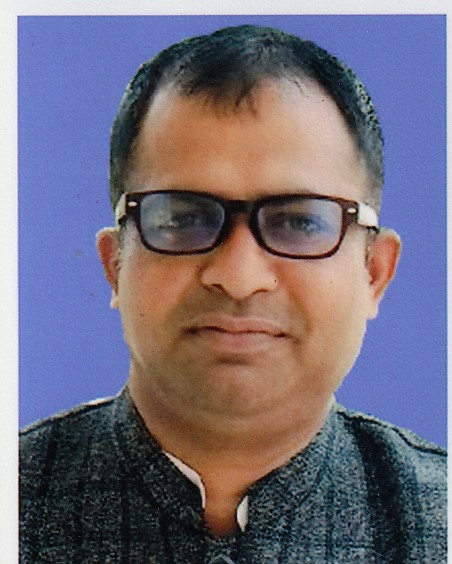The Union Minister for Finance and Corporate Affairs Smt. Nirmala Sitharaman presented the Interim Union Budget 2024-25 in Parliament, yesterday.
It's pity that the total revenue receipts for fiscal year 2023-24 are Rs. 30.03 lakh crores, whereas the revised estimate of total expenditure is approximately 44.90 lakh crores. It means that the total revenue is less than the total expenditure. As a common citizen of India, are we able to see the development of Rs. 44.90 lakh crores in India?
The petrol price has increased, the gas price has also increased, and inflation has also increased, but the life of the common man remains very common. The life of municipal councillors, respective state members of the legislative assembly (MLA), member of Parliaments and all government bureaucrats are growing. However, salary class is suffering lots as no one represents the class who work very hard for the country call India and unfortunately illiterate or certified so-called ruling party leaders, leaders of other political parties and business groups supporting political parties are enjoy all the benefits like a king of India. The maximum citizen of India is unaware of the number of zeros needed to calculate 45 lakh crores.
Revised Estimates (RE) 2023-24
- RE of the total receipts other than borrowings is Rs.27.56 lakh crore, of which the tax receipts are Rs.23.24 lakh crore.
- RE of the total expenditure is Rs.44.90 lakh crore.
- Revenue receipts at Rs.30.03 lakh crore are expected to be higher than the Budget Estimate, reflecting strong growth momentum and formalization in the economy.
- RE of the fiscal deficit is 5.8 per cent of GDP for 2023-24.
Budget Estimates 2024-25
- Total receipts other than borrowings and the total expenditure are estimated at Rs.30.80 and Rs.47.66 lakh crore respectively.
- Tax receipts are estimated at Rs.26.02 lakh crore.
- Scheme of fifty-year interest free loan for capital expenditure to states to be continued this year with total outlay of Rs.1.3 lakh crore.
- Fiscal deficit in 2024-25 is estimated to be 5.1 per cent of GDP
- Gross and net market borrowings through dated securities during 2024-25 are estimated at Rs.14.13 and Rs.11.75 lakh crore respectively.
The key highlights of the Budget are as follows:
- Government assisted 25 crore people out of multi-dimensional poverty in last 10 years.
- DBT of Rs. 34 lakh crore using PM-Jan Dhan accounts led to savings of Rs. 2.7 lakh crore for the Government.
- PM-SVANidhi provided credit assistance to 78 lakh street vendors. 2.3 lakh have received credit for the third time.
- PM-JANMAN Yojana to aid the development of particularly vulnerable tribal groups (PVTG).
- PM-Vishwakarma Yojana provides end-to-end support to artisans and crafts people engaged in 18 trades.
- PM-KISAN SAMMAN Yojana provided financial assistance to 11.8 crore farmers.
- Under PM Fasal BimaYojana, crop insurance is given to 4 crore farmers.
- Electronic National Agriculture Market (e-NAM) integrated 1361 mandis, providing services to 1.8 crore farmers with trading volume of Rs. 3 lakh crores.
- 30 crore Mudra Yojana loans given to women entrepreneurs.
- Female enrolment in higher education gone up by 28%.
- In STEM courses, girls and women constitute 43% of enrolment, one of the highest in the world.
- Over 70% houses under PM Awas Yojana given to women from rural areas.
- Despite COVID challenges, the target of three crore houses under PM Awas Yojana (Grameen) will be achieved soon.
- Two crores more houses to be taken up in the next five years.
- 1 crore households to obtain 300 units free electricity every month through rooftop solarization.
- Each household is expected to save Rs.15000 to Rs.18000 annually.
- Healthcare cover under Ayushman Bharat scheme to be extended to all ASHA workers, Anganwadi Workers and Helpers.
- Pradhan Mantri Kisan Sampada Yojana has benefitted 38 lakh farmers and generated 10 lakh employment.
- Pradhan Mantri Formalisation of Micro Food Processing Enterprises Yojana has assisted 2.4 lakh SHGs and 60000 individuals with credit linkages.
- A corpus of Rs.1 lakh crore to be established with fifty-year interest free loan to provide long-term financing or refinancing with long tenors and low or nil interest rates.
- A new scheme to be launched for strengthening deep-tech technologies for defence purposes and expediting ‘atmanirbharta’.
- Capital expenditure outlay for Infrastructure development and employment generation to be increased by 11.1 per cent to Rs.11,11,111 crore, that will be 3.4 per cent of the GDP.
- A provision of Rs.75,000 crore rupees as fifty-year interest free loan is proposed to support milestone-linked reforms by the State Governments.
Railways
- 3 major economic railway corridor programmes identified under the PM Gati Shakti to be implemented to improve logistics efficiency and reduce cost
- Energy, mineral and cement corridors
- Port connectivity corridors
- High traffic density corridors
- Forty thousand normal rail bogies to be converted to Vande Bharat standards.
Aviation Sector
- Number of airports in the country doubled to 149.
- Five hundred and seventeen new routes are carrying 1.3 crore passengers.
- Indian carriers have placed orders for over 1000 new aircrafts.
Green Energy
- Coal gasification and liquefaction capacity of 100 MT to be set up by 2030.
- Phased mandatory blending of compressed biogas (CBG) in compressed natural gas (CNG) for transport and piped natural gas (PNG) for domestic purposes to be mandated.
Tourism sector
- States to be encouraged to take up comprehensive development of iconic tourist centres including their branding and marketing at global scale.
- Framework for rating of the tourist centres based on quality of facilities and services to be established.
- Long-term interest free loans to be provided to States for financing such development on matching basis.
Investments
- FDI inflow during 2014-23 of USD 596 billion was twice of the inflow during 2005-14.
Direct taxes
- FM proposes to retain same tax rates for direct taxes
- Direct tax collection tripled, return filers increased to 2.4 times, in the last 10 years
- Government to improve tax payer services
- Outstanding direct tax demands upto Rs 25000 pertaining to the period upto FY 2009-10 withdrawn
- Outstanding direct tax demands upto Rs 10000 for financial years 2010-11 to 2014-15 withdrawn
- This will benefit one crore tax payers
- Tax benefits to Start-Ups, investments made by Sovereign wealth funds or pension funds extended to 31.03.2025
- Tax exemption on certain income of IFSC units extended by a year to 31.03.2025 from 31.03.2024
Indirect taxes
- FM proposes to retain same tax rates for indirect taxes and import duties
- GST unified the highly fragmented indirect tax regime in India
- Average monthly gross GST collection doubled to Rs 1.66 lakh crore this year
- GST tax base has doubled
- State SGST revenue buoyancy (including compensation released to states) increased to 1.22 in post-GST period(2017-18 to 2022-23) from 0.72 in the pre-GST period (2012-13 to 2015-16)
- 94% of industry leaders view transition to GST as largely positive
- GST led to supply chain optimization
- GST reduced the compliance burden on trade and industry
- Lower logistics cost and taxes helped reduce prices of goods and services, benefiting the consumers
Tax rationalization efforts over the years
- No tax liability for income upto Rs 7 lakh, up from Rs 2.2 lakh in FY 2013-14
- Presumptive taxation threshold for retail businesses increased to Rs 3 crore from Rs 2 crore
- Presumptive taxation threshold for professionals increased to Rs 75 lakh from Rs 50 lakh
- Corporate income tax decreased to 22% from 30% for existing domestic companies.
- Corporate income tax rate at 15% for new manufacturing companies\
According to finance The Union Minister for Finance and Corporate Affairs, the budget focuses on inclusive growth, economic stability, strategic global positioning, sector-specific developments, environmental sustainability, and tax reforms, with an overarching vision towards a developed India by 2047.
The ruling party have any answer why cities of Gujarat are not developed road infrastructure, Health care, education, social securities, sports facilities like states of the USA for example California, New York, Washington. Can we consider current government is not able to provide a road map to success by 2030? The transparency is lacking the number presented by the Union Minister for Finance and corporate affairs.
Until 2047, the BJP party will be in control of India. Long-term team planning is an excellent strategy, but 28 years is not too long of a tenure. Although the BJP has been in control of Gujarat state for the last 29 years, development has not been noticeable compared to any other state in the USA or any other developed country. What could be the reason for this?
After 29 years of the ruling, the BJP party has any answer why cities of Gujarat are not developed basic facilities like the facilities available in the cities of developed countries for common citizens, 29 years are not sufficient? Can we assume that the current government is not capable of providing a roadmap to success by 2030? There is a lack of transparency in the numbers presented by the Union Minister for Finance and corporate affairs. The citizens of India must question why the wealth accumulation of MPs, MLAs, councillors, and government bureaucrats has increased by 10x to 2000x.
0 thoughts on “Interim Budget 2024: Summary and facts”
Leave a Reply
Your email address will not be published. Required fields are marked *
RECENT NEWS
- Chandrika, Wouter, and Eru win Grammy for 'Triveni'
- Bianca sparks fury with her explicit dress at the Grammy
- Basant Panchami Amrit Snan LIVE: Last holy dip of Mahakumbh begins, lakhs of devotees gather at Triveni Sangam
- Vanga: Chay’s real-life style inspired Kabir Singh, Animal
- Jackky's cousin Vicky hosts star-studded sangeet



















